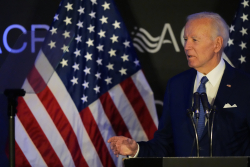
In 2020, Joe Biden won California by 30 points, but at the same time, a statewide effort to restore race-based affirmative action, Proposition 16, failed by double digits. In 2023, the U.S. Supreme Court struck down race-based affirmative action on college campuses. Sixty-five House Democrats, including former House Speaker Nancy Pelosi and the chamber’s current minority leader, Hakeem Jeffries, lined up with the plaintiffs, Harvard and the University of North Carolina.
 Class Matters: The Fight to Get Beyond Race Preferences, Reduce Inequality, and Build Real Diversity at America’s Colleges by Richard Kahlenberg PublicAffairs, 384 pp.
Class Matters: The Fight to Get Beyond Race Preferences, Reduce Inequality, and Build Real Diversity at America’s Colleges by Richard Kahlenberg PublicAffairs, 384 pp. Enter Richard Kahlenberg with his latest book, Class Matters, subtitled The Fight to Get Beyond Race Preferences, Reduce Inequality, and Build Real Diversity at America’s Colleges.
In the case that reached the Supreme Court, Kahlenberg, a frequent contributor to the Washington Monthly, testified as an expert witness in opposition to race-based admissions at UNC. At first blush, the move was incongruous. Kahlenberg is a “liberal maverick.” He idealizes Martin Luther King Jr., Robert Kennedy, and William O. Douglas, the longest-serving Supreme Court justice and New Dealer, still loathed on the right. A graduate of Harvard College and law school, Kahlenberg directs the American Identity Project at the Progressive Policy Institute, a centrist Democratic think tank.
His book is a compelling and provocative examination of the places of race, privilege, and money in college admissions—an issue with stark political implications, for both parties, but Democrats in particular. Kahlenberg prizes racial diversity on campus but is alarmed by racially conscious means to attain that goal. He is mindful of slavery and its legacy, but is aware of the growing divide within the U.S. between the economic “haves” and “have-nots”. The resulting read is nuanced, sober, and granular.
Toting statistics, Kahlenberg persuasively argues here, as he has throughout his career, that class poses a greater barrier to the American Dream than race. (See “Racial Diversity Without Racial Preferences,” Washington Monthly, April/May 2016, one of many he’s written for this magazine on the topic.) At UNC-Chapel Hill, “60 percent of … students came from the top 20 percent of the income distribution, compared with 3.8 percent from the bottom 20 percent of the income distribution. More students at UNC came from the top 5 percent than the bottom 60 percent by income.” The fact that North Carolina is a state school makes the class disparity even more glaring.
The son of a Harvard grad, Kahlenberg also inveighs against legacy admissions. “Research found these preferences, purportedly used only as a ‘tiebreaker,’ in fact added the equivalent of 160 SAT points for a typical applicant,” he observes, caustically. “Legacy preferences shielded wealthy white applicants from having to sacrifice as part of Harvard’s effort to allocate seats for Black and Hispanic students through racial preferences.”
And he chides the virtue signaling of some alumni to be particularly appalling.
“The most nefarious thing about the whole arrangement was that liberal white legacy applicants could be admitted to Harvard and at the same time signal their virtue by lecturing less advantaged Asian applicants about the importance of not being so small-minded and intolerant.”
In local, state, and national elections, such smugness continues to cost Democrats the support of working-class voters, of any color. Although the party’s collapse with this constituency isn’t caused just by its embrace of affirmative action, it’s a big part of it.
Consider Stuyvesant High School, a fabled academic pressure cooker of a public school in New York City, whose admissions had long been based entirely on test performance, and that Kahlenberg defends. Three-quarters of the student body are Asian American, and four-in-nine students come from lower-income households. Few would confuse Stuyvesant with a New England boarding school.
“This was not a school for rich white students,” Kahlenberg writes. “However, some on the left viewed Asian Americans as ‘white adjacent,’ so they were part of the problem.” The condescension or the not-so-thinly-veiled bigotry did not amuse him, nor New York voters.
Under former Mayor Bill de Blasio, Stuyvesant expanded the Discovery program to boost the number of seats available to students attending disadvantaged schools who scored below the standard testing cut-off. The legality of the change is presently being litigated in the federal courts. A decision rendered in 2024 by the U.S. Court of Appeals has cast a pall over the program’s constitutionality.
In recent elections, proponents of race-blind admissions to the city’s elite public schools found strong support in areas with large Asian and immigrant populations. In 2021, Curtis Sliwa, the perennial Republican mayoral candidate, took just 29 percent of the vote—but managed to land 44 percent “in precincts where more than half of the residents are Asian, surpassing his 40 percent of votes in white enclaves, 20 percent in majority-Hispanic districts and 6 percent in majority-Black districts.”
In June 2023, in elections to Community Education Councils, New York City’s equivalent of local school boards, candidates who supported test-based high school admissions punched above their weight. In Queens last November, Grace Meng, a Democrat, won reelection to the U.S. House. Her heavily Asian-American district swung heavily to Trump, however.
These political tremors lead Kahlenberg to write approvingly of programs like the “Top 10 percent Plan,” a race-blind admissions process adopted by the University of Texas that automatically admits students with the top grades at any high school to the system’s flagship school, The University of Texas/Austin.
“The resulting Black and Hispanic populations were slightly larger than they had been when UT used racial preferences,” Kahlenberg writes. He also blisters at the label of “extreme right” for those who oppose these racially neutral measures.
In the wake of the Supreme Court’s decision not to impose color-blindness on the nation’s military service academies, the Monthly’s Will Norris noted West Point and the others “have figured out how to diversify admissions without sacrificing high standards—or running afoul of the Supreme Court. Civilian colleges could do the same,” [See “How the Military Can Save Affirmative Action.”]
Democrats ought to take heed, as should wealthy universities, which could adopt similar high-school programs like the service academies have. After all, the Biden administration took notice of the backlash against affirmative action too late. Harris made “equity,” aka equality of outcome, a touchstone of her 2020 campaign’s closing days. She observed, “There’s a big difference between equality and equity.”
On Inauguration Day 2021, Biden issued his “Executive Order On Advancing Racial Equity and Support for Underserved Communities Through the Federal Government.” “Equality of opportunity” was apparently insufficient.
Here’s one more electoral factoid, also New York-based: On Election Day, 2024, in the congressional district represented by Alexandria Ocasio-Cortez, voters swung heavily toward Trump. A 55-point deficit was cut almost in half. In 2026 and 2028, Democrats can be mindful of these landmines while vigorously prosecuting a Trump administration that purges a Black Chairman of the Joint Chiefs of Staff and Toni Morrison from the U.S. Naval Academy’s library. Whether they are capable of actually triangulating very much remains to be seen.
The post Diversity Without Racial Preference appeared first on Washington Monthly.


 5 hours ago
4
5 hours ago
4 










 Bengali (Bangladesh) ·
Bengali (Bangladesh) ·  English (United States) ·
English (United States) ·